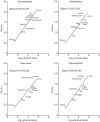Comparison of rotator cuff muscle architecture between humans and other selected vertebrate species
- PMID: 24072803
- PMCID: PMC3898624
- DOI: 10.1242/jeb.083923
Comparison of rotator cuff muscle architecture between humans and other selected vertebrate species
Abstract
In this study, we compare rotator cuff muscle architecture of typically used animal models with that of humans and quantify the scaling relationships of these muscles across mammals. The four muscles that correspond to the human rotator cuff - supraspinatus, infraspinatus, subscapularis and teres minor - of 10 commonly studied animals were excised and subjected to a series of comparative measurements. When body mass among animals was regressed against physiological cross-sectional area, muscle mass and normalized fiber length, the confidence intervals suggested geometric scaling but did not exclude other scaling relationships. Based on the architectural difference index (ADI), a combined measure of fiber length-to-moment arm ratio, fiber length-to-muscle length ratio and the fraction of the total rotator cuff physiological cross-sectional area contributed by each muscle, chimpanzees were found to be the most similar to humans (ADI=2.15), followed closely by capuchins (ADI=2.16). Interestingly, of the eight non-primates studied, smaller mammals such as mice, rats and dogs were more similar to humans in architectural parameters compared with larger mammals such as sheep, pigs or cows. The force production versus velocity trade-off (indicated by fiber length-to-moment arm ratio) and the excursion ability (indicated by fiber length-to-muscle length ratio) of humans were also most similar to those of primates, followed by the small mammals. Overall, primates provide the best architectural representation of human muscle architecture. However, based on the muscle architectural parameters of non-primates, smaller rather than larger mammals may be better models for studying muscles related to the human rotator cuff.
Keywords: Architecture; Muscle; Rotator cuff.
Figures










Similar articles
-
Rotator cuff muscle architecture: implications for glenohumeral stability.Clin Orthop Relat Res. 2006 Jul;448:157-63. doi: 10.1097/01.blo.0000194680.94882.d3. Clin Orthop Relat Res. 2006. PMID: 16826111
-
Cross-Sectional Area of the Rotator Cuff Muscles in MRI - Is there Evidence for a Biomechanical Balanced Shoulder?PLoS One. 2016 Jun 23;11(6):e0157946. doi: 10.1371/journal.pone.0157946. eCollection 2016. PLoS One. 2016. PMID: 27336464 Free PMC article.
-
The entire rotator cuff contributes to elevation of the arm.J Orthop Res. 1994 Sep;12(5):699-708. doi: 10.1002/jor.1100120513. J Orthop Res. 1994. PMID: 7931787
-
Shoulder muscle activity and function in common shoulder rehabilitation exercises.Sports Med. 2009;39(8):663-85. doi: 10.2165/00007256-200939080-00004. Sports Med. 2009. PMID: 19769415 Review.
-
The moment arms of the muscles spanning the glenohumeral joint: a systematic review.J Anat. 2019 Jan;234(1):1-15. doi: 10.1111/joa.12903. Epub 2018 Nov 8. J Anat. 2019. PMID: 30411350 Free PMC article.
Cited by
-
Muscle Architecture Properties of the Deep Region of the Supraspinatus: A Cadaveric Study.Orthop J Sports Med. 2024 Oct 14;12(10):23259671241275522. doi: 10.1177/23259671241275522. eCollection 2024 Oct. Orthop J Sports Med. 2024. PMID: 39421045 Free PMC article.
-
Arthroscopic Tenotomy of the Long Head of the Biceps Tendon and Section of the Anterior Joint Capsule Produce Moderate Osteoarthritic Changes in an Experimental Sheep Model.Int J Environ Res Public Health. 2021 Jul 13;18(14):7471. doi: 10.3390/ijerph18147471. Int J Environ Res Public Health. 2021. PMID: 34299937 Free PMC article.
-
Musculoskeletal architecture of the shoulder: A comparative anatomy study in bats and mice informing human rotator cuff function.bioRxiv [Preprint]. 2025 Jul 8:2025.07.04.663211. doi: 10.1101/2025.07.04.663211. bioRxiv. 2025. PMID: 40672282 Free PMC article. Preprint.
-
Epaxial muscle fiber architecture favors enhanced excursion and power in the leaper Galago senegalensis.J Anat. 2015 Oct;227(4):524-40. doi: 10.1111/joa.12351. Epub 2015 Jul 16. J Anat. 2015. PMID: 26184388 Free PMC article.
-
Bromocriptine mesylate improves glucose tolerance and disposal in a high-fat-fed canine model.Am J Physiol Endocrinol Metab. 2020 Jul 1;319(1):E133-E145. doi: 10.1152/ajpendo.00479.2019. Epub 2020 May 27. Am J Physiol Endocrinol Metab. 2020. PMID: 32459527 Free PMC article.
References
-
- Abramoff M. D., Magelhaes P. J., Ram S. J. (2004). Image processing with ImageJ. Biophotonics Int. 11, 36-42
-
- Adams J. E., Zobitz M. E., Reach J. S., Jr, An K. N., Steinmann S. P. (2006). Rotator cuff repair using an acellular dermal matrix graft: an in vivo study in a canine model. Arthroscopy 22, 700-709 - PubMed
-
- Alexander R. M., Jayes A. S., Maloiy G. M. O., Wathuta E. M. (1981). Allometry of the leg muscles of mammals. J. Zool. 194, 539-552
-
- Bassett R. W., Browne A. O., Morrey B. F., An K. N. (1990). Glenohumeral muscle force and moment mechanics in a position of shoulder instability. J. Biomech. 23, 405-415 - PubMed
Publication types
MeSH terms
Grants and funding
LinkOut - more resources
Full Text Sources
Other Literature Sources

